
Even if you are not a fan of magical realism - which, after spending five years in Latin America, I can assure you is a misnomer; every word of Garcia Marquez' books is true - you should read his memoir, Living to Tell the Tale.
Garcia Marquez published his novel, One Hundred Years of Solitude, when he was 40. Prior to writing what would become one of the enduring classics of the 20th century, he worked as a journalist in Bogota. He wrote sporadic short stories, and a novella, but most of his time was absorbed by exposing government corruption.
During his years as a journalist, he spent every lunch hour in a cafe with a group of colleagues where they would pass the afternoon tearing each other's work to shreds. By the time Garcia Marquez was ready to lock himself in a room and write the epic of Macondo, he had been honed to a razor's edge.
That is how you learn to be a great writer.
_____________________________
The magician in his labyrinth
The Economist, April 26, 2014
IN JULY 1965 Gabriel García Márquez—Gabo to all who revered him later—decided to lock himself away in a house on Calle de La Loma in Mexico City. He ordered his wife to sell the car and get credit from the butcher. For 15 months, using only his index fingers, he typed for six hours a day in a room he called “The Cave of the Mafia”. He survived on a diet of good Scotch and constant cigarettes. At five in the afternoon he would emerge into the fading light with his eyes wide, as though he had discoursed with the dead.
Inside the four walls of that room lay the immense delta of the Magdalena river, the grey frothy sea of Colombia’s Caribbean coast, the suffocating swamps of the Ciénaga, the interminable geometries of the banana plantations, and a long railway line that ran into the farthest territories of his heart. It ended at the village of Aracataca, now renamed by him Macondo, where his maternal grandparents had brought him up amid prospectors, fornicators, gypsies, scoundrels and virginal girls bent over their sewing frames. In that room where he had locked himself away he inhaled the sweet milk-candy and oregano of his grandmother and absorbed again the political venting of his grandfather, who had fought on the Liberal side in the War of a Thousand Days and who, at the book’s beginning, took him to discover ice, a great block of infinite internal needles that boiled his hand when he touched it.
“One Hundred Years of Solitude”, the fruit of his self-imprisonment, sold 50m copies in more than 30 languages. Critics observed that its style, magical realism as they called it, was not new: Jorge Luis Borges, a blind Argentine poet, had felt his way through those labyrinths before. But its fame was startling. The world was seduced by a Latin America where the Buendía family feuded internally and externally, with rifles or with silence, for generations; where death gave its female victims instructions to sew their own shrouds; where the blood from a suicide by shotgun flowed all through Macondo, carefully avoiding the carpets; and where Remedios the Beauty was taken up to heaven as she hung out sheets on the washing line.
Read the rest of the article here.
 RSS Feed
RSS Feed